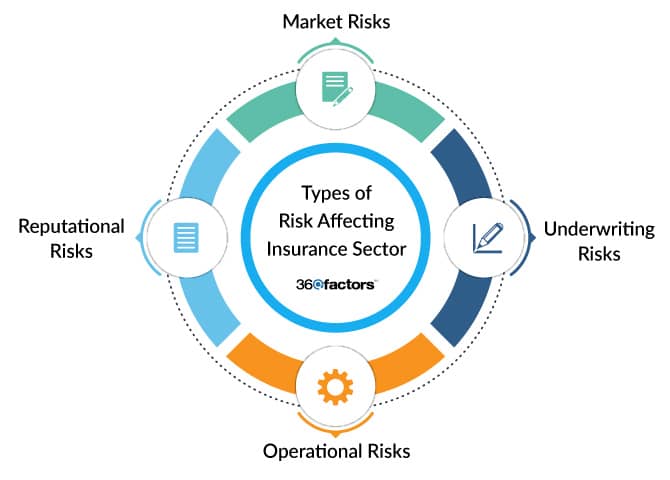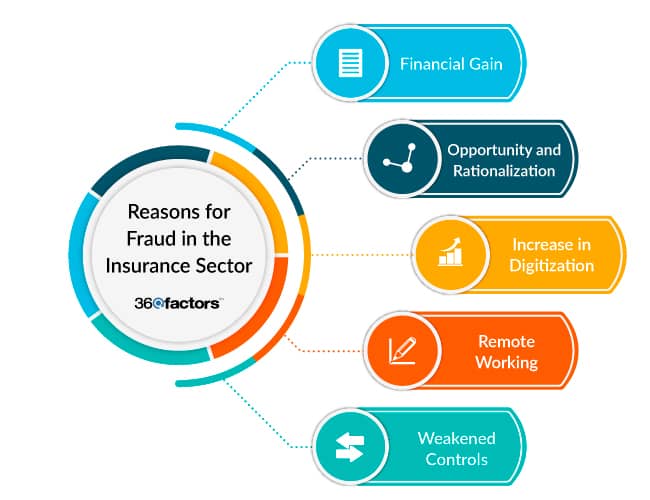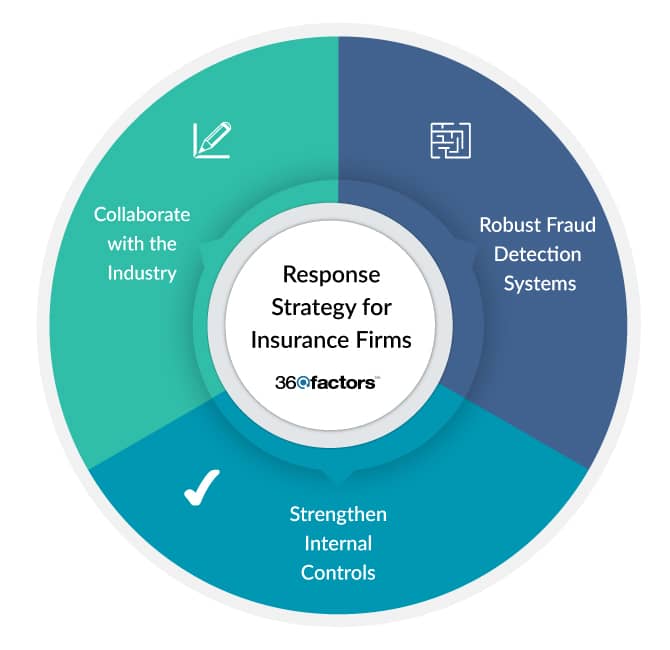Home/ Blog / A Strategy for Navigating Fraud Risks and Building Resilience in the Insurance Sector
The insurance sector plays a pivotal role in safeguarding individuals and businesses against various risks, providing financial protection and peace of mind. However, like any industry, the insurance sector is not immune to risks, and one of the critical challenges it faces is the prevalence of fraud.
In this blog, we will delve into the major types of risks affecting the insurance sector and explore why frauds occur within this industry. Additionally, we will discuss effective strategies that insurance firms can adopt to respond to fraud and build resilience.
Major Types of Risks Affecting the Insurance Sector
The insurance sector faces various risks, which can be categorized into the following four areas.

Market Risks
Market risks within the insurance sector are multifaceted, arising mainly from external economic factors that can significantly impact an insurance company’s financial stability.
- Interest Rate Fluctuations: Insurance companies often invest premiums in interest-bearing instruments. Market interest rate fluctuations can affect the returns on these investments, impacting the company’s profitability.
- Investment Value Volatility: The value of investments held by insurance companies, such as stocks and bonds, can be subject to market volatility. Sudden declines in investment values may lead to financial losses.
- Economic Conditions: Broader economic shifts, such as recessions or economic downturns, can impact policyholder behavior and the demand for insurance products, affecting revenue streams.
Underwriting Risks
Underwriting risks stem from the process of assessing and assuming risk associated with policyholders., Misjudgments in this regard can have significant financial implications for insurance businesses.
- Inaccurate Risk Assessment: Errors in evaluating the risk profile of policyholders can lead to inadequate premium pricing, resulting in financial losses if claims exceed the premiums collected.
- Inadequate Underwriting Guidelines: Poorly defined or outdated underwriting guidelines can expose insurers to unforeseen risks, leading to financial instability.
- Lack of Diversification: Concentrating risks within specific markets or industries without sufficient diversification can also amplify the impact of adverse events.
Operational Risks
Operational risks are inherent to the internal processes and systems of an insurance company and can disrupt its day-to-day operations.
- System Failures: Technical glitches, cyberattacks, or system malfunctions can disrupt insurance operations, impacting customer service and data security.
- Human Errors: Mistakes made by employees in claims processing, customer scrutiny, or policy administration can lead to financial losses and reputational damage.
- Inadequate Processes: Inefficiencies or gaps in operational processes may result in delayed claim settlements, customer dissatisfaction, and increased operational costs.
Reputational Risks
Reputational risks are associated with how an insurance company is perceived by the public, clients, and stakeholders.
- Poor Customer Service: Inadequate customer service, unresolved complaints, and unsatisfactory claims experiences can tarnish an insurer’s reputation.
- Ethical Lapses: Unethical business practices, non-compliance with regulations, or involvement in controversial activities can lead to a loss of trust among clients and stakeholders.
- Negative Publicity: Any adverse event that garners public attention through media or social platforms can quickly damage an insurance company’s reputation, affecting customer acquisition and retention.
Why Are Frauds Happening in the Insurance Industry
A recent report from Deloitte found that fraudulent activity is on the rise in the Insurance sector. The Insurance Fraud Survey focused on interviewing senior leaders within the sector. An overwhelming majority indicated that they witnessed a significant increase in fraud post-Covid.
Frauds in the insurance industry occur for several reasons, and understanding the motivations behind them is crucial for developing effective countermeasures.
Financial Gain
The lure of financial gain remains a primary motivator for insurance fraud. Fraudsters may see insurance policies as a quick and relatively straightforward way to obtain substantial sums of money, either through inflated claims or staged incidents.
Individuals facing financial hardships are more likely to resort to insurance fraud as a means to alleviate their economic struggles. The promise of a financial windfall through fraudulent claims can be tempting for those facing financial difficulties or significant debts.
Opportunity and Rationalization
Some individuals may engage in insurance fraud when they believe there is an opportunity to exploit weaknesses in the system. This could include gaps in oversight, lax internal controls, or situations where detection is less likely.
Perpetrators rationalize their fraudulent activities, convincing themselves that their actions are justified under the circumstances. This internal rationalization can make individuals more prone to committing fraud when presented with an apparent opportunity.
Increase in Digitization
As the insurance industry undergoes digital transformation, fraudsters see this as an opportunity to exploit vulnerabilities in digital systems. The increased reliance on online processes and cloud systems is creating new avenues for fraud, such as identity theft or hacking into digital platforms.
Unlike face-to-face dealing, the digital landscape allows for a certain degree of anonymity, making it easier for fraudsters to engage in illicit activities without the fear of immediate identification. The anonymity provided by digital transactions has emboldened individuals to commit insurance fraud remotely.
Remote Working
The shift towards remote working during the COVID-19 pandemic created new challenges in terms of supervising employees and ensuring adherence to established protocols. This reduced oversight has created opportunities for internal fraud, where employees take advantage of the remote working environment to engage in fraudulent activities.
The line between personal and professional life can blur in a remote working setting. This ambiguity may lead some individuals to rationalize fraudulent actions, believing that the boundaries are more flexible when working from home.
Weakened Controls
In situations where internal controls for insurance underwriting or insurance claims are weak or inadequately enforced, individuals may find it easier to engage in insurance fraud without fear of detection. Weak controls can provide the necessary cover for fraudulent actions to go unnoticed.
When oversight controls are weak, there is a perception among employees and external actors that the likelihood of facing consequences for fraudulent behavior is minimal. This perception can embolden individuals to attempt fraudulent activities.
Common Types of Insurance Fraud
The most common types of insurance fraud include the following.

- Falsifying claims occur when policyholders exaggerate or fabricate claims to receive undeserved payouts.
- Staged accidents are also common, where criminal networks orchestrate accidents to generate fraudulent claims.
- Identity theft has risen as hackers and fraudsters are increasingly using stolen identities to purchase insurance policies or make false claims.
How Can Insurance Firms Respond to Fraud
Addressing fraud in the insurance sector requires a multi-faceted approach, incorporating advanced technologies and robust internal controls.

Implement Robust Fraud Detection Systems
Leveraging advanced data analytics and AI technologies can help identify patterns indicative of fraud, enabling quicker and more accurate detection. Machine Learning algorithms, in particular, are proving effective as they can continuously evolve and adapt to new fraud patterns, enhancing the effectiveness of fraud detection systems.
Strengthen Internal Controls and Compliance Measures
Insurers should focus on training employees about the risks of fraud and instill a culture of integrity to prevent internal fraud. They must conduct frequent audits and reviews of internal processes to uncover vulnerabilities and strengthen controls.
Insurers must also utilize risk assessment, monitoring, and mitigation software, as well as compliance management tools, to prepare more effectively against risks and compliance breaches.
Collaboration and Information Sharing Within the Industry
Collaboration with other insurance firms is another effective strategy for preventing insurance fraud. This involves the exchange of best practices and insights to stay ahead of emerging fraud trends.
Sharing information about known fraudsters and suspicious activities through databases can help insurers collectively combat fraud in this sector.
Conclusion
As evident from Deloitte’s survey, many insurance firms realize that fraudsters and cybercriminals already use advanced technology to commit fraud. It is imperative that insurance businesses adopt technology as well to mitigate organizational risks.
Platforms like Predict360 Risk and Compliance Management can play a crucial role in fraud detection and risk assessment by harnessing the power of advanced technologies. Its modules offer support in risk insights, risk control assessment, IT Risk Assessment, internal audit and findings management, compliance management, regulatory change management, and policy and procedure management. The platform provides comprehensive support for the insurance sector to identify, categorize, monitor, and mitigate risks while ensuring compliance with regulations.
Navigating risks including fraud risk requires a proactive and comprehensive approach from insurance businesses. By staying vigilant and adopting a holistic strategy, insurance firms can not only detect and prevent fraud but also fortify their position in a dynamic and competitive market.
Request a Demo
Complete the form below and our business team will be in touch to schedule a product demo.
By clicking ‘SUBMIT’ you agree to our Privacy Policy.



